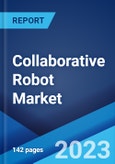The global collaborative robot market size reached US$ 1.9 Billion in 2022. Looking forward, the publisher expects the market to reach US$ 16.8 Billion by 2028, exhibiting a growth rate (CAGR) of 40.8% during 2023-2028.
A collaborative robot, also known as a cobot, is a robot that can learn multiple tasks to assist human beings. It relies on machine vision, cognitive computing, and touch and mobile technologies for being aware about its surroundings through demonstration and reinforcement learning. It consumes less energy than its larger autonomous counterparts and uses collision detection to avoid injuring human coworkers. Additionally, it minimizes errors, increases productivity and offers better operating results. As a result, it finds extensive applications in electronics, automotive, manufacturing and food and beverage (F&B) industries worldwide.
A collaborative robot, also known as a cobot, is a robot that can learn multiple tasks to assist human beings. It relies on machine vision, cognitive computing, and touch and mobile technologies for being aware about its surroundings through demonstration and reinforcement learning. It consumes less energy than its larger autonomous counterparts and uses collision detection to avoid injuring human coworkers. Additionally, it minimizes errors, increases productivity and offers better operating results. As a result, it finds extensive applications in electronics, automotive, manufacturing and food and beverage (F&B) industries worldwide.
Collaborative Robot Market Trends:
At present, there is a considerable rise in the demand for collaborative robots with high payload capacity across the globe. This, along with the growing automation in different industries, especially in developing economies, represents one of the key factors driving the market. In addition, there is an increase in the integration of torque and force sensing technologies in robots across the globe. This, coupled with the rising employment of collaborative robots for manufacturing purposes, such as on the assembly lines and welding, is impelling the growth of the market. Apart from this, the escalating demand for user-friendly robots, which do not require a highly-skilled workforce to carry out operations, is stimulating the growth of the market. Furthermore, the rising demand for collaborative robots in the packaging industry to enhance their production rates is stimulating the market growth. Besides this, the increasing usage of collaborative robots in the logistics industry to overcome challenges, such as handling complicated work processes and numerous tasks in combinations, is projected to propel their overall sales and profitability in the coming years.Key Market Segmentation:
The publisher provides an analysis of the key trends in each sub-segment of the global collaborative robot market report, along with forecasts at the global, regional and country level from 2023-2028. The report has categorized the market based on component, payload, application and end use industry.Breakup by Component:
- Hardware
- Software
Breakup by Payload:
- Upto 5 Kg
- 5-10 Kg
- Above 10 Kg
Breakup by Application:
- Material Handling
- Pick and Place
- Assembly
- Palletizing and De-Palletizing
- Others
Breakup by End Use Industry:
- Automotive
- Electronics
- Manufacturing
- Food and Beverage
- Chemicals and Pharmaceutical
- Others
Breakup by Region:
- North America
- United States
- Canada
- Asia-Pacific
- China
- Japan
- India
- South Korea
- Australia
- Indonesia
- Others
- Europe
- Germany
- France
- United Kingdom
- Italy
- Spain
- Russia
- Others
- Latin America
- Brazil
- Mexico
- Others
- Middle East and Africa
Competitive Landscape:
The competitive landscape of the industry has also been examined along with the profiles of the key players being ABB Ltd., AUBO (Beijing) Robotics Technology Co. Ltd., DENSO WAVE Incorporated (Denso Corporation), Doosan Robotics Inc. (Doosan Group), Fanuc Corporation, Kawasaki Heavy Industries Ltd., KUKA AG (Midea Group), Omron Corporation, Precise Automation Inc. (Brooks Automation Inc), Rethink Robotics GmbH, TechMan Robot Inc. (Quanta Storage Inc.), Universal Robots (Teradyne Inc) and Yaskawa Electric Corporation.Key Questions Answered in This Report:
- How has the global collaborative robot market performed so far and how will it perform in the coming years?
- What has been the impact of COVID-19 on the global collaborative robot market?
- What are the key regional markets?
- What is the breakup of the market based on the component?
- What is the breakup of the market based on the payload?
- What is the breakup of the market based on the application?
- What is the breakup of the market based on the end use industry?
- What are the various stages in the value chain of the industry?
- What are the key driving factors and challenges in the industry?
- What is the structure of the global collaborative robot market and who are the key players?
- What is the degree of competition in the industry?
Table of Contents
1 Preface3 Executive Summary12 Value Chain Analysis14 Price Analysis
2 Scope and Methodology
4 Introduction
5 Global Collaborative Robot Market
6 Market Breakup by Component
7 Market Breakup by Payload
8 Market Breakup by Application
9 Market Breakup by End Use Industry
10 Market Breakup by Region
11 SWOT Analysis
13 Porters Five Forces Analysis
15 Competitive Landscape
Companies Mentioned
- ABB Ltd.
- AUBO (Beijing) Robotics Technology Co. Ltd.
- DENSO WAVE Incorporated (Denso Corporation)
- Doosan Robotics Inc. (Doosan Group)
- Fanuc Corporation
- Kawasaki Heavy Industries Ltd.
- KUKA AG (Midea Group)
- Omron Corporation
- Precise Automation Inc. (Brooks Automation Inc)
- Rethink Robotics GmbH
- TechMan Robot Inc. (Quanta Storage Inc.)
- Universal Robots (Teradyne Inc)
- Yaskawa Electric Corporation
Methodology

LOADING...
Table Information
| Report Attribute | Details |
|---|---|
| No. of Pages | 142 |
| Published | September 2023 |
| Forecast Period | 2022 - 2028 |
| Estimated Market Value ( USD | $ 1.9 Billion |
| Forecasted Market Value ( USD | $ 16.8 Billion |
| Compound Annual Growth Rate | 43.8% |
| Regions Covered | Global |
| No. of Companies Mentioned | 13 |









